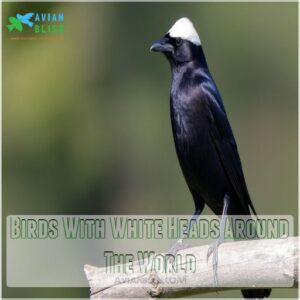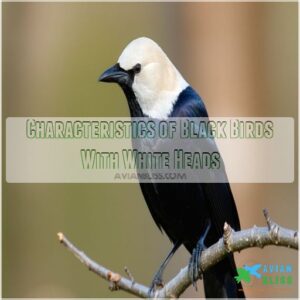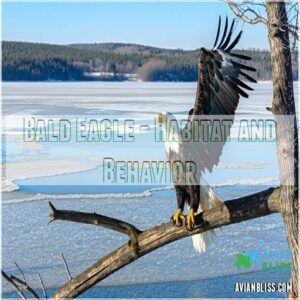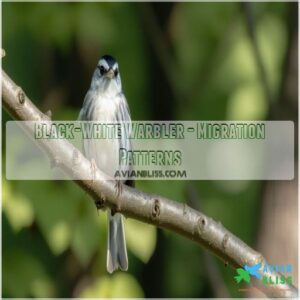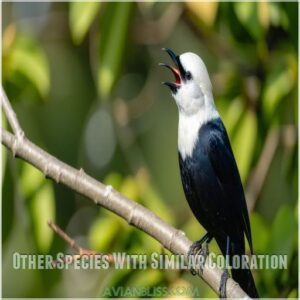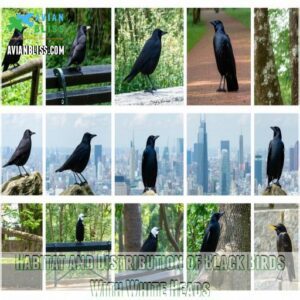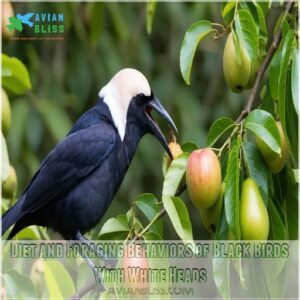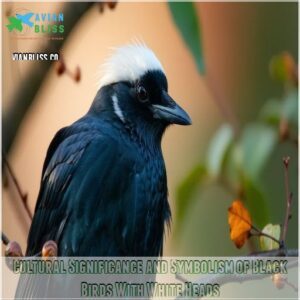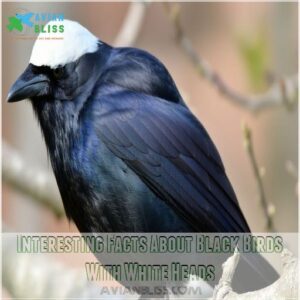This site is supported by our readers. We may earn a commission, at no cost to you, if you purchase through links.
 When you spot a black bird with a white head, it’s like finding the yin-yang symbol in nature.
When you spot a black bird with a white head, it’s like finding the yin-yang symbol in nature.
One striking example is the White-headed Woodpecker.
Found in the pine forests of North America, this bird flaunts a black body with a mostly white head.
Males sport a dashing red patch on their crown, a bit like wearing a jaunty cap.
With sharp, pointed beaks, they peck away bugs hiding behind tree bark.
These woodpeckers are true artists in the forest, and there’s more to learn about their fascinating habits and habitats if you’re ready to dig a bit deeper!
Table Of Contents
- Key Takeaways
- Birds With White Heads Around The World
- Black Bird With White Head Identification
- Characteristics of Black Birds With White Heads
- Species With Black and White Coloration
- Habitat and Distribution of Black Birds With White Heads
- Diet and Foraging Behaviors of Black Birds With White Heads
- Cultural Significance and Symbolism of Black Birds With White Heads
- Conservation Status of Black Birds With White Heads
- Interesting Facts About Black Birds With White Heads
- Frequently Asked Questions (FAQs)
- What kind of bird is black with a white head?
- What bird is black with a white cap?
- Can a grackle have a white head?
- What is a black bird with a white crown?
- How do black birds with white heads migrate?
- What attracts black birds with white heads?
- How to distinguish juvenile black birds with white heads?
- What predators hunt black birds with white heads?
- Do black birds with white heads interbreed with other species?
- Conclusion
Key Takeaways
- You’ll find black birds with white heads all over the world, each showcasing unique adaptations to diverse habitats.
- These birds are not just visually striking; they play crucial roles in their ecosystems, from predators like the Bald Eagle to scavengers like the White-headed Vulture.
- Cultural significance surrounds these birds, often seen as symbols of freedom and strength, bridging myths and modern symbolism.
- Conservation efforts are vital, as many species face threats from habitat loss and climate change, but initiatives are underway to protect and preserve them.
Birds With White Heads Around The World
You’ll find black birds with white heads in every corner of our planet, from the majestic Bald Eagle of North America to the striking White-headed Vulture of Africa.
Whether you’re watching them soar above mountain peaks or patrol coastlines, these distinctive birds showcase nature’s artistic touch with their bold black-and-white patterns.
Their bold black-and-white patterns help them stand out in their diverse habitats.
North American Birds With White Heads
Ever spotted a majestic bird with a striking white head soaring across North America’s skies?
You’re probably thinking of the iconic Bald Eagle, but there’s more to discover.
From the compact Downy Woodpecker to the fish-hunting Western Osprey, these remarkable creatures showcase nature’s diversity.
The White-headed Woodpecker and Pacific Gull round out this impressive lineup, each bringing their unique charm to our forests and coasts.
South American Birds With White Heads
While exploring South America’s diverse rainforests, you’ll discover some remarkable black birds with white heads that’ll take your breath away.
These unique species have adapted perfectly to their environments, from dense jungles to coastal regions.
You can even find products inspired by these birds with white heads at online stores like bird white head products.
Some of the most intelligent bird species, like the American Crow’s problem-solving skills, reside in North America, but here are four stunning South American species you won’t want to miss:
- Black and White Marsh Tyrant, sporting a crisp white head
- Black and White Hawk-Eagle, with its piercing yellow eyes
- Blue-throated Piping Guan, showing off its elegant crested head
- Black-faced Hawk, displaying its distinctive red beak
African Birds With White Heads
The Common Loon, a bird with a black and white patterns, showcases the unique characteristics of birds found in various ecosystems. Africa’s diverse landscapes burst with remarkable black birds sporting white heads.
From the majestic White-headed Vulture soaring over savannas to the White-headed Barbet darting through forests, you’ll discover unique species adapted to various habitats.
| Species | Size (inches) | Notable Feature |
|---|---|---|
| White-headed Vulture | 36-40 | 7-foot wingspan |
| White-headed Barbet | 7-8 | Thick, strong beak |
| White-crested Hornbill | 23-25 | Curved yellow bill |
| Palm-nut Vulture | 28-30 | Fruit-based diet |
Australian Birds With White Heads
Down under, Australia’s birds sport their own unique take on the black-and-white look.
You’ll spot the White-headed Pigeon strutting through eastern coastal forests, showing off its snowy head and dark wings.
Notably, this look isn’t exclusive to Australia, with birds like the white crowned pigeon thriving in the mangrove forests and coastal habitats of southern Florida.
This plump beauty reaches 16 inches long, with males flashing a striking red bill tipped in yellow.
The Black-banded Fruit Dove adds to Australia’s collection, mixing white head features with a fruit-loving lifestyle.
Black Bird With White Head Identification
Identifying a black bird with a white head might seem tricky at first, as there are various species like the black bird with white spots that can make identification challenging, but you’ll become a pro with these simple tips.
Start by checking the bird’s size – is it as big as a crow or small like a sparrow?
Next, note where you spot it – whether it’s soaring overhead, perched on a branch, or wading in water.
A Bald Eagle’s stark white head stands out against its dark body, while the White-headed Vulture shows subtle cream tones.
You’ll find the White-headed Woodpecker darting up tree trunks, and the Black-faced Hawk prefers open spaces.
For precision, grab your binoculars and look for distinctive markings like eye color, bill shape, and any patches of color besides black and white.
Location matters too – different species call different regions home.
Characteristics of Black Birds With White Heads
You’ll spot these striking birds by their unmistakable contrast of jet-black bodies paired with bright white heads, ranging from the massive bald eagle with its 7-foot wingspan to the compact white-headed woodpecker.
Each species shows off unique features you can identify, from the curved beaks of vultures to the straight, chisel-like bills of woodpeckers, while their sizes vary from small songbirds to impressive raptors.
Distinctive Plumage Patterns
The striking contrast of black-and-white plumage patterns in birds like the White-headed Woodpecker serves as nature’s masterpiece.
You’ll notice distinctive variations between males and females, with males often sporting additional red patches.
Camouflage plays a key role, especially in species like the Black and White Hawk-Eagle, where their pattern helps them blend into dappled forest light.
Regional differences create unique color variations across continents.
Beak Shapes and Sizes
Every black bird with a white head sports a uniquely adapted beak, often influenced by their varied habitats and behaviors, such as nesting in coniferous forests.
You’ll spot powerful hooked beaks on predatory species like the Bald Eagle, perfect for tearing prey.
The White-headed Woodpecker’s chisel-like bill drills into tree bark, while the White-headed Black Bulbul’s slender beak skillfully plucks berries.
The Palm-nut Vulture evolved a specialized curved beak just for cracking open palm nuts.
Leg and Foot Structures
Looking beyond those powerful beaks, you’ll find a world of amazing leg and foot adaptations. These black-and-white beauties showcase nature’s engineering at its finest, with each species sporting unique features to match their lifestyle.
- Yellow-legged gulls rock webbed feet perfect for paddling through waves
- Woodpeckers grip tree bark with zygodactyl toes – two forward, two back
- Eagles wield massive talons for snatching prey
- Magpies strut on strong, scaled legs built for ground foraging
Variations in Size and Weight
When you spot black birds with white heads in the wild, you’ll notice incredible size variations across species.
From tiny songbirds to massive raptors, these creatures showcase nature’s diversity.
Here’s a quick comparison of some notable species:
| Species | Average Weight | Wing Span |
|---|---|---|
| White-headed Black Bulbul | 1.4 oz | 12 inches |
| White-headed Woodpecker | 2.3 oz | 16 inches |
| Black-faced Hawk | 1.5 lbs | 3.2 feet |
| Black and White Hawk-Eagle | 2.8 lbs | 4.1 feet |
| White-headed Vulture | 9.2 lbs | 7.5 feet |
Unique Vocalizations and Calls
Beyond their striking size differences, these black-and-white beauties are vocal virtuosos.
You’ll hear bald eagles’ piercing screams echo across lakes, while magpies chatter like gossiping neighbors.
The white-headed marsh tyrant’s sharp "chip-chip" cuts through wetland fog, and ospreys’ distinctive "cheep" signals their return from fishing trips.
Each species has mastered its own unique symphony in nature’s orchestra.
Species With Black and White Coloration
You’ll find an amazing variety of black birds with white heads across North America, from the majestic Bald Eagle to the nimble Black-and-White Warbler.
Each species has adapted its black-and-white pattern for different purposes, whether it’s the Osprey’s high-contrast fishing camouflage or the Magpie’s social signaling to its flock members.
Bald Eagle – Habitat and Behavior
You’ll find bald eagles soaring over diverse habitats, from coastal areas to inland waterways across North America.
These majestic birds build massive nests in tall trees, sometimes weighing up to 2,000 pounds!
They’re expert fishers, using their razor-sharp talons to snatch prey from the water’s surface.
While they prefer fish, they’re opportunistic hunters who’ll also feast on waterfowl and even steal food from other birds.
Osprey – Nesting and Mating Habits
The Western Osprey’s nesting habits are a masterclass in architectural precision.
These skilled builders construct massive stick nests up to 6 feet wide in tall trees or platforms near water.
They’re loyal partners, returning to the same nest year after year, adding new materials each spring.
During breeding season, males court females with dramatic aerial displays and fresh-caught fish presentations, cementing their lifelong bond.
Magpie – Social Structure and Intelligence
Magpies demonstrate remarkable intelligence through their complex social networks and problem-solving abilities.
You’ll often spot these black-and-white birds working together in family groups, sharing food, and defending territory.
They’re skilled tool users, can recognize themselves in mirrors, and even mimic human speech.
Their tight family bonds extend beyond breeding pairs, with younger birds helping raise their siblings – a rare trait among avian species.
Black-White Warbler – Migration Patterns
Migratory masters, Black-and-White Warblers set out on an incredible journey twice yearly between breeding grounds in North America and wintering habitats in Central and South America.
These spirited birds navigate an astonishing 3,000-mile round trip.
- They’re among the first warblers to arrive in spring, showing up when trees are barely budding
- Most travel at night, using stars for navigation
- Some individuals return to the exact same breeding territory year after year
Other Species With Similar Coloration
Beyond the familiar black-and-white warbler’s migration routes, you’ll find several stunning birds sporting similar color patterns.
Some notable species include the striking White-headed Black Bulbul, with its jet-black body contrasting against a snowy head, and the majestic Black and White Hawk-Eagle, whose bold plumage serves as both camouflage and display.
Even the Western Osprey joins this monochromatic club with its distinctive markings.
Habitat and Distribution of Black Birds With White Heads
You’ll find these striking black birds with white heads in nearly every corner of Earth, from the dense rainforests of South America to the urban parks in your own neighborhood.
These remarkable birds have adapted to thrive in diverse habitats worldwide.
Whether you’re spotting a majestic bald eagle soaring over North American lakes or watching a white-headed vulture gliding above African savannas, you’ll discover these remarkable birds have adapted to thrive in diverse habitats worldwide.
Forest Dwellers – Trees and Canopies
Deep in the forest canopy, you’ll find remarkable black birds with white heads perfectly adapted to life among the trees.
The White-headed Woodpecker thrives in old-growth forests, while the Black and White Hawk-Eagle soars through tropical rainforest gaps hunting prey.
These skilled forest dwellers have evolved specialized features like strong claws for gripping bark and keen eyesight for spotting food through dense foliage.
Wetland Inhabitants – Marshes and Swamps
Throughout history, wetlands have been prime real estate for black birds with white heads.
You’ll spot these stunning creatures darting through cattails and gliding over murky waters.
Here’s what makes wetland birds unique:
- Black and White Marsh Tyrants rule the roost with their distinctive white crowns
- White-headed Vultures scan marshes for prey from towering cypress trees
- Ospreys dive-bomb into swamp waters, snatching fish with surgical precision
Grassland Residents – Prairies and Meadows
You’ll find several black birds with white heads thriving in grassland habitats.
The White-headed Marsh Tyrant claims territories in tall prairie grasses, while the Black and White Hawk-Eagle soars above meadow edges hunting for prey.
These species have adapted unique nesting strategies, often building their homes in isolated grass clumps or small trees scattered throughout these open landscapes, away from urban areas.
Urban Adaptations – Cities and Towns
Several black birds with white heads have mastered city living, turning skyscrapers into makeshift cliffs and parks into hunting grounds.
Many have even adapted their songs to overcome the challenges of urban noise pollution, such as singing at higher frequencies.
You’ll spot White-headed Woodpeckers drilling into wooden telephone poles, while Black Bulbuls dart between urban trees.
These adaptable species have learned to use human structures for nesting, finding creative food sources in gardens, and even treating city noise as part of their daily soundtrack.
Migration Routes and Patterns
Following ancient pathways across continents, black birds with white heads showcase remarkable migration patterns.
You’ll spot bald eagles soaring south from Alaska to California during winter, while swallow-tailed kites journey from Florida to Brazil.
These birds time their travels with seasonal changes, following food sources and nesting opportunities.
Eastern Bluebirds that inhabit the eastern United States, known for their rich blue top and rusty orange belly, navigate through weather patterns and geographical features like coastlines and mountain ranges guide their incredible journeys.
Diet and Foraging Behaviors of Black Birds With White Heads
You’ll find that black birds with white heads display remarkable variety in their dining habits, from the bald eagle’s skillful fish-catching techniques to the white-headed vulture’s essential role as nature’s cleanup crew.
These striking birds have adapted their hunting and foraging strategies to suit their environments, whether they’re snatching fish from the water’s surface, picking through tree bark for insects, or soaring high above the savannah in search of their next meal.
Omnivorous Diets – Seeds, Fruits, and Insects
Black birds with white heads showcase remarkable dietary flexibility, adapting their food choices as seasons change.
Just like smart shoppers at a buffet, these birds mix up their menu throughout the year.
Here’s what makes up their diverse diet:
- Fresh berries and wild fruits during summer months
- Various seeds from local vegetation year-round
- Small insects caught mid-flight or picked from bark
- Tree sap and flower nectar when available
Carnivorous Diets – Small Animals and Carrion
Powerful instincts drive these black and white hunters to pursue their prey.
You’ll find they’ve adapted to hunt everything from tiny mice to fallen deer.
Check out these fascinating carnivorous diets:
| Species | Primary Prey | Secondary Prey | Hunting Style |
|---|---|---|---|
| White-headed Vulture | Carrion | Small mammals | Ground scavenging |
| Black and White Hawk-Eagle | Wood-quails | Toucans | Aerial pursuit |
| Palm-nut Vulture | Palm nuts | Fish | Perch hunting |
| African Fish Eagle | Fish | Water birds | Diving strikes |
Foraging Strategies – Hunting and Scavenging
Throughout the day, you’ll spot these remarkable birds employing diverse foraging strategies.
White-headed vultures soar effortlessly on thermal currents, scanning for carrion with their keen eyesight.
Ospreys showcase spectacular diving abilities, plunging from heights to snatch fish.
Bald eagles combine both hunting and scavenging, often stealing food from other birds or waiting patiently near fishing boats for easy meals.
Tool Use and Problem-Solving
Several white-headed black birds showcase remarkable tool-use abilities.
You’ll find White-headed Woodpeckers crafting specialized holes to store acorns, while Black and White Hawk-Eagles use twigs to probe for prey in tree cavities.
Even more impressive, White-headed Marsh Tyrants have been observed dropping insects into water to clean them before eating.
These birds’ problem-solving skills rival those of primates, demonstrating their exceptional intelligence.
Adaptations to Human-Modified Environments
Many black birds with white heads have mastered city life.
White-headed Woodpeckers using metal poles as drumming posts, while Black and White Hawk-Eagles now hunt in urban parks.
They’ve learned to use artificial light for extended foraging hours and found new food sources in our gardens.
Even White-headed Marsh Tyrants have adapted, nesting in drainage ditches and catching insects around streetlights.
Cultural Significance and Symbolism of Black Birds With White Heads
You’ll discover these striking creatures in the myths and legends of cultures worldwide, where they’ve played roles ranging from wise messengers to powerful spirit guides.
Black birds with white heads are depicted as sacred beings that connect the earthly and spiritual domains in Native American traditions, while in modern times they’re often seen as symbols of freedom and strength.
Mythological Representations – Good Luck and Bad
Ancient tales paint black birds with white heads as symbols of dual fortunes.
In Norse mythology, you’ll find the whiteheaded woodpecker bringing good tidings, while Roman folklore warns of albino blackbirds as omens.
Many people also find inspiration in black bird symbolism, incorporating it into their everyday lives through various products like black bird gifts.
Chinese traditions celebrate the whiteheaded black bulbul as a harbinger of prosperity, yet some European tales cast these striking creatures as tricksters who’ll steal your luck when you least expect it.
Spiritual Significance – Messengers and Guides
Indigenous cultures worldwide view black birds with white heads as spiritual messengers.
They’re believed to bridge the gap between earth and sky.
You’ll find these striking creatures appearing in sacred ceremonies, where they’re believed to bridge the gap between earth and sky.
Like the White-headed Vulture in African traditions or the Bald Eagle in Native American spirituality, they’re seen as guides carrying prayers to the divine and bringing wisdom back to those seeking answers.
Folklore and Fairy Tales – Tricksters and Heroes
Throughout folklore across cultures, black birds with white heads play dual roles as both wise guides and mischievous tricksters.
You’ll find these distinctive creatures in Native American tales, where they’re often portrayed as clever problem-solvers who outsmart larger animals.
European fairy tales cast them as mystical messengers, while African stories feature them as shape-shifting spirits who teach valuable life lessons through their pranks.
Modern Symbolism – Freedom and Power
Ever wondered why black birds with white heads capture our imagination?
These striking creatures have become powerful symbols in modern culture.
You’ll find the bald eagle on everything from coins to corporate logos, representing freedom and strength.
The white-headed vulture symbolizes wisdom and vision in African cultures, while the osprey’s graceful flight embodies independence and precision in maritime communities worldwide.
Conservation Efforts and Threats
Several black birds with white heads face mounting threats in today’s changing world.
Habitat loss and climate change pose serious risks, while pollution and invasive species disrupt their natural environments.
You’ll find dedicated conservation teams working to protect these magnificent creatures through habitat restoration, breeding programs, and public awareness campaigns.
Despite these challenges, there’s hope as successful recovery efforts show positive results, especially among bald eagles and ospreys.
Conservation Status of Black Birds With White Heads
You’ll find that many black birds with white heads face serious challenges from habitat loss and climate change, though some species like the bald eagle have made remarkable comebacks.
If you’re interested in helping these magnificent birds thrive, learning more about the tallest bird in North America, the Whooping Crane Habitat can be crucial in understanding their needs. you can support conservation efforts through local wildlife organizations that protect their nesting sites and feeding grounds.
Threats to Black Bird Populations
Modern threats to black birds with white heads paint a stark picture of survival challenges.
Habitat loss from urban sprawl forces species like the White-headed Woodpecker from their homes, while climate change disrupts migration patterns.
Pesticide use weakens populations of the Black and White Hawk-Eagle, and disease outbreaks hit the White-headed Pigeon particularly hard.
Human development continues shrinking their natural territories worldwide.
Conservation Efforts and Initiatives
Conservation heroes worldwide are stepping up to protect black birds with white heads through innovative initiatives.
From wildlife sanctuaries to international partnerships, these efforts are making a real difference in preserving these magnificent creatures.
Many also support conservation by purchasing eco-friendly products from organizations dedicated to Black bird white head conservation, such as those found on Conservation Gear Online.
- Captive breeding programs have successfully reintroduced endangered species
- Protected areas now span millions of acres across continents
- Advanced tracking systems monitor migration patterns
- Specialized rehabilitation centers nurse injured birds back to health
Let’s discover how these conservation champions are safeguarding our feathered friends for future generations.
Role of Humans in Black Bird Conservation
You’ve got more power than you think in protecting black birds with white heads.
By supporting sustainable agriculture and reducing pesticide use, you’re helping preserve key habitats, such as those found in the diverse landscapes of birdwatching hotspots in North America.
Get involved in citizen science projects to track bird populations, or join local conservation groups.
Even small changes, like keeping cats indoors and maintaining bird-friendly yards, make a real difference in protecting these stunning species.
Interesting Facts About Black Birds With White Heads
You mightn’t expect black birds with white heads to have such unique lifestyles, but their mating rituals and social structures are fascinating.
They put on some of the most elaborate courtship displays you’ll see, and their group dynamics can rival any soap opera.
Unique Mating and Breeding Habits
Protecting these birds is key.
Let’s look at their amazing love lives! Many species have unique mating habits.
Think about it:
- Whiteheaded Black Bulbuls sing beautiful songs to attract mates.
- Whiteheaded Woodpeckers perform elaborate dances.
- Whiteheaded Marsh Tyrants build impressive nests.
- Whiteheaded Pigeons coo softly, creating a romantic mood.
Their nesting preferences and courtship rituals vary widely, showcasing nature’s creativity.
Complex Social Structures
When exploring complex social structures in black birds with white heads, you’ll notice some fascinating behaviors.
Many species engage in cooperative breeding, where birds band together to raise young.
Dominance hierarchies are the rule, not the exception, guiding territorial defense and communication methods.
Whether it’s the White-headed Marsh Tyrant or the White-headed Black Bulbul, group foraging is teamwork in its finest, ensuring survival.
Adapt
Black birds with white heads are masters of adaptation.
The Common Grackle’s iridescent glossy black plumage is an impressive sight. Facing evolutionary pressures and climate change, these birds have developed behavioral adaptations to survive.
They adjust their feeding habits and nesting sites, showing resilience in human-altered landscapes.
Next time you spot a white-headed blackbird, think of it as nature’s clever survival artist, adapting to an ever-changing world with ease.
Frequently Asked Questions (FAQs)
What kind of bird is black with a white head?
Picture a bold black bird with a striking white head—it’s the Swallow-tailed Kite.
This acrobatic raptor, found in the Americas, swoops gracefully through the sky, contrasting its white head with the dark wings and tail.
What bird is black with a white cap?
You might be thinking of a Black-and-White Warbler, known for its bold black and white stripes and a distinctive white cap on its head.
These energetic little birds often creep along tree bark in search of insects.
Can a grackle have a white head?
Grackles, typically dark, don’t naturally sport white heads. That snowy crown? It’s likely an anomaly, a rare genetic quirk, or maybe even a clever disguise.
What is a black bird with a white crown?
When you spot a black bird with a white crown, you’re likely observing a White-crowned Sparrow.
Though mostly in North America, these sparrows sport a distinctive white and black striped head, adding flair to their subtle plumage.
How do black birds with white heads migrate?
Black birds with white heads, like eagles, set out on graceful glides guided by wind currents.
Migration patterns vary, with some soaring solo while others flock together for warmth.
They travel vast distances to find suitable breeding grounds.
What attracts black birds with white heads?
You’re drawn to these birds’ unique charm. Food, specifically, attracts them – insects, seeds, and fruits are favorites, while some species, like the Black-billed Magpie, enjoy scraps and small mammals.
How to distinguish juvenile black birds with white heads?
Spot juvenile kin by examining size and plumage.
Youthful charmers often flaunt smaller statures and muted hues.
Their fledgling feathers, tan or gray-tinted, contrast starkly with adult’s vivid visage, making them both fascinating and formidable to identify.
What predators hunt black birds with white heads?
Predators like hawks, falcons, and larger owls hunt birds with distinctive color patterns like black bodies and white heads.
These skilled hunters use their acute vision and swift aerial attacks to catch unsuspecting birds mid-flight.
Do black birds with white heads interbreed with other species?
Interbreeding’s rare, but it happens!
Genetic compatibility plays a big role.
Think of it like trying to fit square pegs in round holes—sometimes it works, sometimes it doesn’t.
Hybrids, when they occur, are often infertile.
Conclusion
Uncover the natural wonder of the black bird with a white head, a living yin-yang symbol fluttering through diverse habitats.
Each species you’ve explored offers unique traits and stories, from the striking plumage of the White-headed Woodpecker to the imposing presence of the Bald Eagle.
These birds inspire awe with their appearance but also through their roles in ecosystems.
Keep your eyes peeled—you might just spot one soaring majestically or nestled quietly in the trees.

